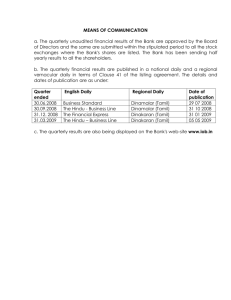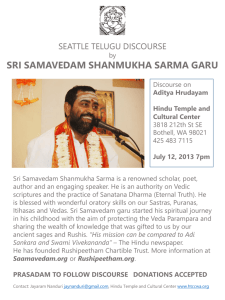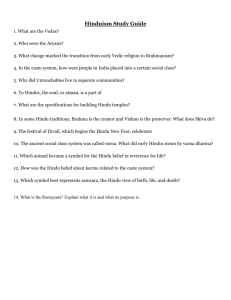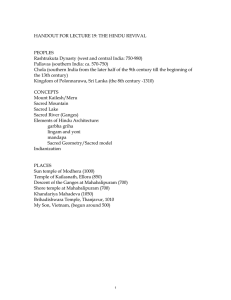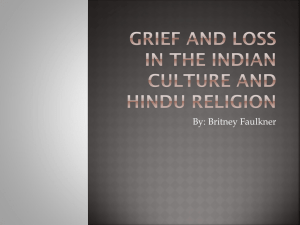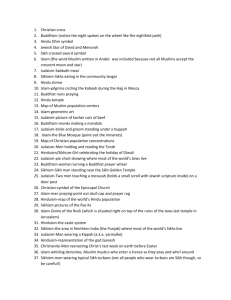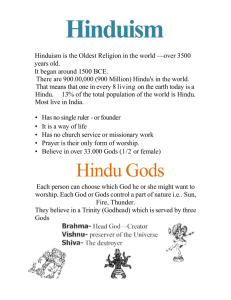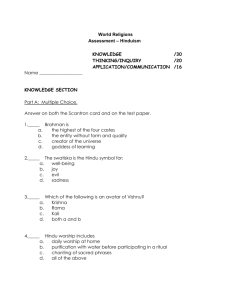Gendering the Divine: New Forms of Feminine Hindu Worship Ann R. David
advertisement
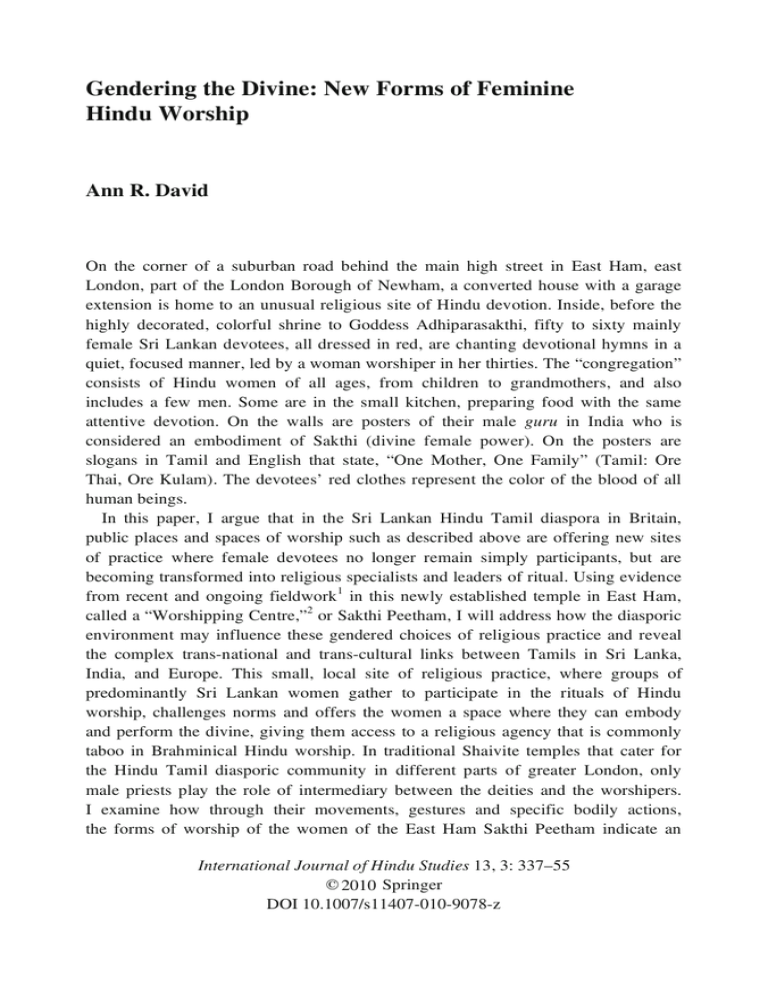
Gendering the Divine: New Forms of Feminine Hindu Worship Ann R. David On the corner of a suburban road behind the main high street in East Ham, east London, part of the London Borough of Newham, a converted house with a garage extension is home to an unusual religious site of Hindu devotion. Inside, before the highly decorated, colorful shrine to Goddess Adhiparasakthi, fifty to sixty mainly female Sri Lankan devotees, all dressed in red, are chanting devotional hymns in a quiet, focused manner, led by a woman worshiper in her thirties. The “congregation” consists of Hindu women of all ages, from children to grandmothers, and also includes a few men. Some are in the small kitchen, preparing food with the same attentive devotion. On the walls are posters of their male guru in India who is considered an embodiment of Sakthi (divine female power). On the posters are slogans in Tamil and English that state, “One Mother, One Family” (Tamil: Ore Thai, Ore Kulam). The devotees’ red clothes represent the color of the blood of all human beings. In this paper, I argue that in the Sri Lankan Hindu Tamil diaspora in Britain, public places and spaces of worship such as described above are offering new sites of practice where female devotees no longer remain simply participants, but are becoming transformed into religious specialists and leaders of ritual. Using evidence from recent and ongoing fieldwork1 in this newly established temple in East Ham, called a “Worshipping Centre,”2 or Sakthi Peetham, I will address how the diasporic environment may influence these gendered choices of religious practice and reveal the complex trans-national and trans-cultural links between Tamils in Sri Lanka, India, and Europe. This small, local site of religious practice, where groups of predominantly Sri Lankan women gather to participate in the rituals of Hindu worship, challenges norms and offers the women a space where they can embody and perform the divine, giving them access to a religious agency that is commonly taboo in Brahminical Hindu worship. In traditional Shaivite temples that cater for the Hindu Tamil diasporic community in different parts of greater London, only male priests play the role of intermediary between the deities and the worshipers. I examine how through their movements, gestures and specific bodily actions, the forms of worship of the women of the East Ham Sakthi Peetham indicate an International Journal of Hindu Studies 13, 3: 337–55 © 2010 2009 Springer DOI 10.1007/s11407-010-9078-z 338 / Ann R. David emerging divergent process of gendering the divine in current Hindu practice. The paper also explores the layered nature of public space, especially where religious ritual is located, revealing the complexity of the diaspora situation or of “diasporic public spaces” (Werbner 2002). It reveals how shifting notions of public and private are employed by Hindu devotees and how a public image can be linked to imagined notions of a global community of religious worshipers. The first section of the paper addresses the major features of female worship at the East Ham temple and gives a brief background to the temple. In the following section, I examine the notion of empowerment of Hindu women, framing the discussion in a wider discourse of women’s religious freedom and drawing on interviews with temple devotees. Lastly, I give a brief migratory history of the Sri Lankan Tamils in the UK and consider the political, social, and migratory factors at play in this globalized, yet local arena. In addition this section examines the categorization of this newly emergent temple as a new religious movement and discusses the notions of divine power and the manifestation of miracles. Finally, I link these arguments to the emerging body of literature on religion, gender, and women’s empowerment. The London Worshipping Centre and the Melmaruvathur Temple in India The devotional rituals at this Worshipping Centre in East Ham, east London emerge from South India, through an umbilical link to the Melmaruvathur Adhiparasakthi Siddhar Peetham, in a village called Melmaruvathur, ninety-six kilometers south of Chennai. Once a small village temple established in the late 1960s, it is now a large complex—housing a free hospital, a school, a college, lodgings and the temple itself, built towards the end of the1990s. A trust that manages the charitable, medical, educational, and cultural aspects of the temple’s work was created in 1978. The worship is of Amma (Mother) as Sakthi (divine female power), also known as Adhiparasakthi, and her appearance is threefold: through the statues of Sakthi in the temple; through the intermediary of a male figure, referred to as Guruji, or sometimes as God; and through his words. This man will go into trance and become the mouthpiece of the goddess, speaking, it is said, in divine oracles. One somewhat hagiographic text states that “from the moment of the Mother entering his body, he walks like a woman and talks in dignified rhythmic language” (Moorthy 1986: 13). Devotees worship the man as Amma or as Adhiparasakthi and use the feminine pronoun when speaking of him. One website devoted to the worship of the goddess notes, “He becomes She,…She is in Him” (Anonymous 2001: 2). The man is Bangaru Adigalar, a devout local man and a married schoolteacher with four grownup children who is now the full-time guru of the temple. He has been “receiving” the goddess since 1970. Nowadays he is described as embodying Sakthi constantly, rather than intermittently as in the past,3 and therefore is seen as the goddess. As Vasudha Narayanan writes, “The identification of Bangaru Adigalar with the Mother Goddess seems to have grown over the years, and he is now simply called ‘Amma’ or Mother by his devotees” (2000: 769; emphasis in original). Gendering the Divine: New Forms of Feminine Hindu Worship / 339 Bangaru Adigalar requests his devotees to establish groups wherever they are settled, and there are now over 4,000 Worshipping Centres in India, North America, Malaysia, Singapore, Australia, Dubai, Europe, and the UK. Unusually, women, without the intermediacy of any priests, carry out the ritual worship, and women of all ages are allowed into the inner sanctuary, regardless of age or issues of impurity related to menstruation. One of the group’s atypical features is that women are trained to carry out public puja and fire sacrifices, yajnas or hommams. Men participate too, but women dominate the public puja. Although the global dissemination of Adigalar’s practices follows the mother temple, the diasporic context in London is particular in that it is the first of the centers to be established in the UK and it is situated in a local area where more “orthodox” Shaivite ritual worship is established. Thus this new Worshiping Centre offers Tamil diasporic women a significant alternative religious base that is distinctive both in terms of practice and meaning. Many of the Hindu women of the London Melmaruvathur Temple have visited the Indian temple, and their UK religious practices follow those at the main temple. These London-based female devotees embody their devotional (bhakti) worship through various practices such as the circumambulation of the shrine on their knees, full bodily protestations, chanting, making kolams (distinctive Tamil geometric floor patterns), preparing food, and bathing of the feet of the guru (in a photo) and through the physical offering of flower petals or vermillion red kum-kum powder to other photos of the deity. Much of this religious behavior is part of ritual worship found in many Shaivite temples, although here there are clearly folk influences and differences that I discuss below. These strategies of hybridization can be seen in many diasporic groups’ cultural and religious practices, as noted by many other scholars (Clothey 2006; Vertovec 1992; Waghorne 2004, for example). The floor patterns are a major feature of the Adhiparasakthi worship, and therefore I focus here on their importance. Traditionally, only women make these kolams, marking the threshold between the public space outside their houses and the entry into their private homes. The designs symbolize beauty, as well as offering a welcome to visitors and marking the home as sacred space. Yet these boundaries of public and private space appear to be more permeable when such patterns are brought into the temple. Vijaya Nagarajan’s work (2007) exploring the spiritual significance of Tamil kolams suggests that the presence of such intricate patterns indicates a space created for ritual purposes. At the London Melmaruvathur Temple, a carefully colored kolam is created on the floor each time worship takes place. It sits approximately four feet in front of the shrine, marking out the ritual space between the shrine and the seated devotees. A tall brass oil lamp is placed at the center of the pattern. The kolam indicates auspiciousness and functions to prevent ritual pollution, thus protecting the purity of the ritual space. Understood by all those present, it is a silent signifier of purity and auspiciousness, demarcating the boundary between sacred and secular, the worldly sphere and the domain of the spiritual, of the gods. As Nagarajan states, “the spatial threshold is a powerful metaphor in Indian secular and sacred life, a charged location between ritually pure and impure or between 340 / Ann R. David auspicious and inauspicious places” (2007: 96). It is also believed to be charged with divine energy, effected through the power of a woman’s hands. Bangaru Adigalar places a marked significance on these floor patterns, calling them chakras (centers of energy thought to exist both outside and inside the physical body) rather than kolams. Books with detailed charts, diagrams, and instructions in Tamil are sent out to Worshipping Centres around the world, and training is also given in the geometrical construction of floor chakras at the temple in India. In London, as described above, they are performed with great devotion and attentive care, as they are considered to be a conduit for the powerful energy of the goddess Sakthi. Meeting at the home of the woman who runs the London center, I was proudly shown her book of chakra directions written by Bangaru Adigalar. In our conversation she gave me an intricate account of the kolams/chakras that had already been created in the ritual at the London temple and the ones which remained to be done. For certain festival occasions, the patterns are set and relate specifically to the particular ritual of that day. These particular patterns are now practised globally in the various Melmaruvathur centers, no longer just remaining in the domain of individual women in their private home spaces. As in the mother temple in India, Tamil is the language of ritual worship at the London center. Sanskrit is not considered to be needed, nor does anyone have any knowledge of or training in it. This is in contrast to the traditionally trained Brahminical priests of the nearby Tamil Shaivite temples in East Ham, who conduct their ritual mantras in Sanskrit.4 In the Sakthi Peetam, a certain order of ritual has evolved, where on the three weekly occasions when the devotees meet, the puja takes different forms. On Tuesdays, the 108 names of Sakthi are chanted, on Thursdays, the recitation is of the 1008 names of Sakthi, and on Friday evenings, bhajans (sacred hymns) are sung in praise of Sakthi and Guruji. These bhajans have been composed by devotees in the past and are now formalized and distributed in booklets for devotees to follow. Apart from the weekly format of worship, the Sakthi Peetham honors significant Hindu festivals such as Tai Pusam, Chitra Purnami, Adi Puram,5 Navratri, as well as Guruji’s birthday (March 3rd), Tamil New Year’s Day (April), New Year’s Day (January 1st), and every full and new moon day of each month. During the festivals of Tai Pusam and Chitra Purnami, fire sacrifices (yajna/ hommam) form the central part of the ritual. Men and women devotees participate, although the greater percentage of those attending are female and events are led as usual by the women. As with all the other ritual that is enacted in the Worshipping Centre, the yajnas have been newly codified and set out by Bangaru Adigalar in order that all worshipers follow the same code of practice. This again appears to contrast with Agamic Shaivite performance, where only the trained male priests can carry out both daily puja and special yajna sacrifices. It is a form that draws from the past but one that offers a contemporary, participatory formula in which devotees can carry out the ritual for themselves. At the Chitra Purnami festival in April 2008 in London which I observed, each worshiper had their own small flame, a replica of the larger, central fire, to which they offered clarified butter (ghi), flowers, and fruit Gendering the Divine: New Forms of Feminine Hindu Worship / 341 during the many hours of the ceremony. All were considered equal and each partook of the potency of the ritual worship. Religious and Social Empowerment Bangaru Adigalar as Amma has declared a mission to elevate women’s status in society and to empower them, not just by seeing them as equal to men, but by giving them preference and priority in their spiritual activities as well as their secular and social roles. E. C. Chandrasekharan notes that “the Sakthi Path visualizes, and has accorded, a very unique role and status for women—even a preferential place to them—to conduct rituals and participate in all spiritual activities without any restriction whatsoever, as the upliftment of women socially and spiritually is the surest way of transforming and transfiguring humanity” (2004: 190). In the context of the strict hierarchical systems which have, historically, dominated Indian society, this re-codified system of religious practice appears to reveal new negotiations in both social and religious domains. Narayanan speaks of the temple being “overtly ‘feminist’ in that it insists on equality between men and women” (2000: 770).6 There are no barriers of caste, gender or age, so widows, menstruating women, and low-caste devotees may all participate and are not prohibited from the ritual, as in many other Hindu temples. The sense of freedom and empowerment in their involvement in ritual practices is the dominating theme spoken of in the conversations and interviews with the women (and the men)7 of the London temple, as I discuss later. This contradicts traditional and current practice in mainstream Hindu temples in India and in the diaspora, where in Brahminical dharmic ritual, male priests direct and control the worship, acting as purified vehicles for the intimate relationship with the deity and offering the only access to divine power for the women.8 The sacred space of the temple is a highly gendered one, despite the fact that many of the deities worshiped have a female form. As Karen Morin and Jeanne Guelke state in their book, Women, Religion and Space, “Religious space often requires a spatial separation of men and women that comes with the associated power differentials. A worship service, for example, may be highly spatialized, as men typically officiate and have control and access to exclusive sites of power (and ‘the sacred’) within a religious building” (2007: xix). It is important to consider here without going into detail that in the history of bhakti worship in India, we can find examples of the reversal of gender roles, such as male devotees of Krishna worshiping as females (Young 1987) and Tamil men encompassing “femaleness” while possessed (Kapadia 2000: 183), as bhakti devotion allows for different kinds of relationships with God. This is apparent in the East Ham center where the male guru is worshiped as a goddess, as discussed. Certain folk or rural practices of Hinduism also permit women a greater freedom and authority, where they can function as religious specialists (Sugirtharajah 1994). Women’s place in religious practice in Hindu traditions is a complex subject and clearly cannot be viewed through a lens of Western feminist standpoints that search 342 / Ann R. David for women’s equality and rights—both “unfamiliar concepts in a religion that has supported a hierarchical social system based on birth and occupation” (Young 1999: 3). Despite areas within Hindu religious practice where women have been subjugated, such as in strict Brahminical spaces where men control the worship, Hindu women, as in many other cultures, have also been empowered by religious practice over the centuries, as Narayanan points out, “The Brahminical Hindu tradition has been marked by the curtailing of freedom to women in the spaces connected with dharmic roles. And yet, it may be argued by some that women in Hindu traditions— either because of or in spite of gender, caste, and class restrictions—have continuously found opportunities to create new spaces for artistic expression and paths to salvation” (2007: 180). Other scholars’ work supports these findings, such as Alleyn Diesel’s (2007: 35) contemporary studies of Hindus in Natal, South Africa, where she records interviews of women in neo-Hindu or reformed Hindu groups who have trained to become priests. This began in the 1980s as part of the Arya Samaj community, and by the late 1990s Pietermaritzburg had eight women Hindu priests. Not only is the Arya Samaj thought to hold more enlightened attitudes regarding male and female roles and relationships than other Hindu religious organizations, but in Pietermaritzburg it is the women priests who are more popular as they are viewed as performing the rituals more efficiently and clearly and as being more progressive than the men. The particularity of the diaspora situation is highlighted here, where a paucity of qualified priests and more open, progressive attitudes have led to new developments in practice, such as those being described in this paper. This significant change of approach is, then, not simply to do with gender empowerment, but also the particular, changing priorities of Hindus in diasporic contexts.9 In the UK, I have observed public worship organized and run by a Sai Baba devotee, a middle-class Guyanese woman who had been instructed by Sai Baba to establish a public shrine in her home and to lead the ritual. At full moon occasions, as many as one hundred people will gather in the extended space of her northwest London home, offering puja to Sai Baba and singing devotional bhajans. She will also go into trance on these occasions, becoming embodied, she believes, by her guru. She told me that she had always questioned traditional worship and saw no need for male priests as intermediaries in devotional practice. These wide-ranging, contemporary examples indicate how new spaces are emerging in the diaspora for Hindu women to become ritual specialists outside of the private domain. One of the first Hindu temples in Britain, and the first in the city of Leicester was founded by a Hindu woman, Shyama Devi, in her own house in a residential street in 1969. Devi was worshiped as a female guru, a living saint. It still today remains a thriving temple, called the Radha Krishna Temple Shyama Ashram. Another British example given by Steve Vertovec (1992) is of a temple founded and run by a Hindu woman devotee in Balham, south London. In a similar way, this female became known as a living guru and would attract worshipers who traveled long distances to take darshan (auspicious sight of the divine10) in her presence and to participate in Gendering the Divine: New Forms of Feminine Hindu Worship / 343 the temple’s rituals. Kim Knott (2000) also notes that diasporic Asian women have always played key roles in community and domestic religious life, but she emphasizes that this is usually in roles that are hidden from public view. The women cited above, in this sense, are the exception. At present, in the early part of the new millennium, in some of the more orthodox Sri Lankan Hindu temples in London (such as the London Sri Murugan Temple in East Ham and the Shri Kanagathurkkai Amman Temple in Ealing), women serve on the committees that run the temples as Trustees, but, of course, do not actively carry out the rituals—a domain solely for the trained male priests. The usual taboos pertain in these orthodox temples: no non-Hindus are allowed in the ritual space before the shrine, no devotee is allowed to touch the deities, and no menstruating women can visit the temple. Women’s ritual practice has always been subject to change, so evidence of new female religious agency is not just related to diasporic practice or the effects of modernity, although the evidence presented here suggests that the creation of new ritual spaces for women certainly appears strongest in neo-Hindu or new variant expressions of Hinduism in the diaspora. Perhaps we are seeing indications of more women exercising agency in religious performance as the divide between the domestic and the public sphere narrows due to increasing mobility of both men and women across transnational borders and in diasporic communities. I am not arguing that the East Ham Shakti Peetham is an extension of the domestic sphere for these women: rather, such public diasporic spaces blur the boundaries of women’s private and public religious practice, allowing them to participate predominantly in public Hindu ritual in new ways outside the home. This is due to the fact that such spaces complexify the idea of the public. The public worship of the East Ham women in the temple, where several hundred devotees may attend on special festival days, is only relatively public. It does not incorporate a wider body of worshipers of other faiths, nor of other ethnicities. It does not attract the “general public.” Therefore these events would perhaps be considered more “private” in terms of the broader public sphere of recognizable multicultural religious practice in the UK, for example, which recognizes Hinduism more by the ritual seen in orthodox temples such as the London Shri Murugan Temple. In this sense, the ambiguity of diaspora environments in relation to notions of public and private may provide the opportunities for women to develop their ritual position. Recent documentation of Hindu practices in the movement across transnational and trans-cultural boundaries (Clothey 2006) notes the prevalence of increased temple ritual and the diminishing of domestic ritual. Temples are providing an extension of the domestic sphere for diasporic groups, offering a committed community of worshipers and ritual practice in a situation where the extended family is not physically present to take care of essential life rituals. In these vast movements by peoples across the globe, religion can offer an emancipatory function, helping women to “transcend existing social restraints and behave in ways contrary to social 344 / Ann R. David expectation” (Pintchman 2007: 5). Most of the women are at work and no longer restricted to the home, experiencing a greater social as well as religious freedom. Perhaps, given the Sri Lankan esteem for culture and religion, a greater freedom for the women is acceptable and allowable when it is seen to be a religious one. Living on the boundaries in a diasporic milieu brings unsought and unforeseen changes which can provoke the need for continuity as well as the desire for innovation. Women gurus or saints, women in possessed states11 or performing bodily mortification rituals such as fire-walking or body piercing (seen now in UK Shaivite practice), all formerly the preserve of men, are indications of a change in gendered practice of Hinduism and of women transcending normative social codes that are embedded in Hindu philosophic thought and expressed in social constraints. Ritual practices such as those named above are increasingly on display in the diasporic context, indicating both a new-found confidence in the settled community (David 2008) and a need, through the performance of more elaborate and dramatic rituals, to heal the tensions and contested narratives experienced in diasporic life. Sri Lankan Diaspora Although the women of the East Ham Sakthi Peetham are physically present in east London, they offer their imagined gaze, their attention, their prayers and devotions wholeheartedly to their guru in India. Several devotees have been to the Indian Melmaruvathur Temple where the guru resides. At the same time, the majority of the group originate from Sri Lanka (although a few South Indians attend), yet their families and friends are resident in Europe, from where many of the community have migrated to the UK. Travel between these continents and the sites of their native homes (Sri Lanka), religious home (India) and extended family homes (Britain, France, Germany, and Switzerland) is frequent, as there is a regular flow to and from Europe, Sri Lanka, North America and India by members of Tamil groups here, despite the violence and aftermath of the civil war in Sri Lanka. Many of these temple attendees are relatively recent migrants from other parts of Europe—France, Germany, Holland, and Switzerland—giving evidence of a secondary migration to the UK that has been accelerated perhaps by desires for the younger generations to gain an English education and by the obvious support of a well-established, significant British-based Tamil community. East Ham, in Newham12 where these Sri Lankan Hindu women gather is home to a large number of displaced Sri Lankan Tamils,13 and there is much evidence of a new sense of place-making, centered on the different temples. It is the strength of the transnational connections of the more settled Tamil migrants14 that draws even greater numbers of Tamils to the borough, seeking asylum, searching for employment and for places of refuge, and creating the second largest refugee community in the borough. Out of nearly 5,000 asylum seekers arriving in 2002 in Britain, the majority of them came from Sri Lanka. It is estimated that nearly one quarter of the British Tamil population are asylum seekers. As far as Gendering the Divine: New Forms of Feminine Hindu Worship / 345 religious worship is concerned, Tamils show by far the highest numbers of participation at Tamil temples or Tamil churches, and the support provided by their community in socio-cultural, religious, and economic ways impacts directly on the settlement experience (see David 2009). In Alice Bloch’s (2002: 79) study of Tamil, Congolese and Somali refugees in London, virtually all Tamil respondents gave their reason for coming to the borough of Newham as kinship or friendship ties or because of other refugees there and the presence of places of worship. Understood in this way, the sense of being at home, or of place-making, is revealed to be multi-layered. The Sri Lankans’ political awareness and cultural ties to their homeland are major factors in their diasporic situation, in the sense of a displaced people whose political and financial support is devoted to rebuilding and supporting their homeland, and their sense of a global, diasporic family is a powerful articulation of Tamil Sri Lankan nationalism (David 2005). Not only is there evidence of settlement in the diaspora, but for many Tamils, the establishment of their own state (Tamil Eelam) in Sri Lanka absorbs much of their emotional, political, and financial capital. It is the epitome of “place-making” in all senses of the term. As with many diaspora groups, attention is focused two ways—to the past and to the future, to the country of origin, and to the current location. For the Sri Lankan Tamils this involves two or more contrasting places (UK, India, Sri Lanka). New Religious Movements What framework is most relevant to examining this particular contemporary fieldwork setting? I would suggest that the factors I discuss in this paper are evidence of a new religious movement or a modern sampradaya, a guru-led organization, that is akin to the worship of other living gurus such as Sai Baba or organizations such as the Brahma Kumaris or ISKCON (International Society for Krishna Consciousness). These groups are all now well-established Hindu spiritual paths that greatly appeal to diasporic Hindus, as evidence shows (Babb 1983; Kent 2004). Such twentiethcentury expressions framed within a Hindu structure describe themselves as spiritual rather than religious in a trajectory marked by a distancing from the more orthodox practices of Shaivite Hindu rituals, for example. One website text describing the Melmaruvathur Temple declares, “It is not a Hindu movement. It is more of a philosophy which accepts and embraces all regions.”15 Bangaru Adigalar is called “a spiritualist” by some (Moorthy 1986), and like Sai Baba, “a living saint” by others. UK Hindu devotees of Sai Baba also speak in the universalist terms of Sai Baba’s teachings.16 The discourse at this predominately Sri Lankan London center, as in the global Sai Baba movement, seeks to reconcile tradition and modernity, home and diaspora, past and present, and offers new understandings for the contemporary and often displaced, diasporic devotee. With mottos (in Tamil and English) displayed on the walls of the London temple that speak of one family, one humanity, and one Mother and which are frequently cited in my interviews with devotees, this reformulated, re-imagined Hindu doctrine presents a world that is free from caste, 346 / Ann R. David gender restrictions, color, and creed. Dominant themes are of miracles that involve the resolution of health crises, pregnancies in the case of women unable to conceive, and job offers where none had been forthcoming. Underlining the contemporary application of divine power, miracles now include the successful receiving of immigrant visas. These themes reflect essential areas of importance to Hindu life and survival and nowadays for those seeking asylum. Furthermore such divine power offers an apparent route to social freedom for devotees who have very little and find themselves often on the lowest rungs of society’s ladder. Proposing “a universalist and modernist form of Hindu devotionalism,” as Alexandra Kent (2004: 47) states in her discussions on Sai Baba worship, these neo-forms of Hindu practice create an accessibility for those without Sanskrit and Agamic knowledge which places them at the very heart of participation in Hindu ritual. Engagement in Bangaru Adigalar’s reformulated, simplified system of prayer, worship, and meditation and the devotional singing of bhajans is the only requirement placed on the Melmaruvathur devotees. This devotional system is a method which utilizes the hymns, or mantras, of the ancient Tamil poets and involves chanting (in Tamil) the 108 names of the divine power Sakthi (laksha-archana) or at other times the 1008 names of the divine, while puja is made to the photos of the guru using variously an arati lamp, red kum-kum powder, or flower petals. The refrain of “om sakthi, om sakthi” is sung at points in the proceedings. Traditional milk abhisheka (ritual bathing of the form of the deity) is also performed, as is the carrying of small lime lamps on a tray around the shrine (vilakku puja). For some, the carrying of these lamps is the most significant part of the puja.17 At the end of the worship, all partake of prasad before the communal eating of a freshly cooked meal, prepared by the devotees. Each day’s ritual takes a different focus and is sponsored by a different family or individual. K. K. Moorthy describes the newly evolved practices in the Indian mother temple as follows: “The temple is justly famous…for its traditions, which are refreshingly new and spiritually elevating. A close scrutiny reveals many new conventions, some of which are found to be either contradictory, or conciliatory to the wellestablished practices; and the rest are in tune with the dynamism of modern times. So, it is a temple with a difference…” (1986: 28). He situates his statements carefully, noting the link of such practices with past tradition, yet emphasizing their essential modernity. Although Moorthy is describing practices at the “home” temple in India, he places his remarks within the global community of Melmaruvathur followers, thus narrowing and challenging the perceived divide between home and diaspora. The East Ham example is a “temple with a difference”; it forms part of a dynamic, global, and transnational network. This has significance for both diaspora and home devotees, in that they partake of global values and participate in a global community of worshipers. In East Ham the Sri Lankan women from complex migratory backgrounds celebrate their Sri Lankan Tamil identity and their local diaspora site, but also take confidence in being a part of the home temple community in Melmaruvathur. Gendering the Divine: New Forms of Feminine Hindu Worship / 347 Miracles and Answered Prayers Discourse that privileges the concept of miracles, as discussed above, immediately raises the question of how to read and understand its significance. As Richard Davis points out, the term “miracle” is an English one “with Western semantic history grounded mainly in Christian terminology and Enlightenment philosophical critique” (1998: 4). There is no Indic word for miracle, yet both European Christian and Indian traditions use phrases relating to wonder and surprise. The most obvious example of this is within the Indian philosophic doctrine which contains a complex system of aesthetics, set out in several ancient and revered texts relating to drama, dance and music, such as the Natya Shastra and the Abhinavabharati.18 These texts articulate a series of eight/nine primary sentiments (rasa) that codify the human response to the world and are expressed through dramatic presentation. Bharata, author of the Natya Shastra, classifies adbhuta (wonder, astonishment, magic) as the eighth rasa, which is aroused by “the sight of divine persons,…by tricks and magic” (Rangacharya 1996: 61). Set out in meticulous detail, these texts are primarily directions for stage actors/dancers, yet such is the centrality of performance within Indian socio-cultural and religious thought, these aesthetic principles infuse daily living and social behavior. Indeed, performativity is at the heart of Hindu religious expression, as I have discussed elsewhere (David 2009). Religious sentiment is codified by the concept of adbhuta, as can be seen in the customary expressions of devotional fervor in any Hindu temple. Observing worshipers taking darshan at the Melmaruvathur Temple one sees obvious displays of wonder and astonishment revealed in their eyes, gestures, and bodily language. I argue that the experience of wonder, grounded in the collective memory of customary religious practice and situated in a worldview that embraces magic and devout astonishment, lays the ground for understanding and acceptance of miraculous events in a religious context. Although part of Hindu belief in a more general context, such miraculous events are particularly relevant to the Melmaruvathur Temple as they are seen to bring power and legitimation, empowering the women and transforming them into religious specialists. Miracles allow the building of faith and indicate that even though this is a small, local site of practice, the devotees will have access to the supernatural realm. This is especially needed in a diasporic situation where social tensions, financial and often legal problems create a contested site for devotees. Is the fervent belief in miracles and their narratives, as expressed by devotees at this temple, and appearing so centrally in other neo-Hindu movements such as the Sai Baba organization, simply an attribution of religious agency, signifying the presence of higher powers or of God in a human form? Miracles are social acts that “require an audience, a community of witnesses, who respond to the event with appropriate reactions of wonder, surprise, astonishment, and delight,” and they presume “a set of socially shared expectations concerning what ought to happen” (Davis 1998: 5). Other factors are at play here, too. For a community who has lived through violent conflict and territorial displacement, these proud narrations of 348 / Ann R. David miraculous powers may be for the Sri Lankan refugees a way of reaffirming faith, of providing evidence of divine protection, and of hope for the future. Moorthy’s (1986) text about Bangaru Adigalar by a devotee entitled The Mother of Melmaruvathur and Her Miracles privileges the presence of miracles in his work and lays emphasis on the divine oracles of the guru and the power of his healing and his visions. Miracles taking place in Sakthi Peethams all over the world are recounted in such texts, as proof of the guru’s power extending throughout the world. A forty-six year old Sri Lankan woman I met at the London Worshipping Centre who came to the UK in 1991 spoke about such power and the miracles experienced at the center: It’s a very unique worship here. We have all the freedom to do what we want. We enjoy coming here. Lots of miracles have happened. I think Sakthi lives in Bangaru Adigalar. She’s very powerful and she gives her devotees the most— whatever they want, she will fulfil their request. Most ladies who haven’t had children for years and years, they’ve now got children. Or children who wouldn’t speak for a long time and now they talk. One gentleman was in a coma for eleven days and he recovered—that sort of thing.19 She continued by listing details about devotees gaining visas and children obtaining success in exams, as well as recounting her own story of a very late and much wished-for marriage and pregnancy. The concept of power was a salient feature raised in many of the interviews, a power described as being centered in the temple and made manifest particularly in the form of miraculous events. This was emphasized by another younger woman in her early thirties who came to the UK via Germany in 1991. She stated: Other temples you can go to and pray but you don’t really see any difference, but you go to this temple and you can really see the difference. You will see the difference. People told me that there was this power there and I didn’t believe them or listen to them. But after I got my job [she had applied for many jobs and not got anywhere] I did believe that there was this power. I went to the interview wearing red and they gave me the job.20 She attributed her successful job application entirely to the power of her attendance and prayers at the temple and the access to the potency made available through their guru. Just as in the first interview above, she too acknowledged the freedom experienced at this London temple, stating, “I feel I can say anything to Amma, so I’m really happy to be there.” For the Hindu women attending this Worshipping Centre, miracles carry an even more potent signification, framed as they are in cultural and social expectations, such as the need to marry, to produce children, and for their husbands to keep in good health. Success in these particular situations is attributed to Amma’s powers and the results perceived as miracles, especially after long years of Gendering the Divine: New Forms of Feminine Hindu Worship / 349 waiting for such outcomes. My ethnographic research into other Sri Lankan Hindu devotional practices (firewalking, trance dancing, body piercing) in the diaspora reveals evidence of ritual actions that many devotees classify as miraculous, and yet other Hindus consider such activities controversial.21 A mile away from the Worshipping Centre in East Ham, a traditionally run Shaivite temple called the London Shri Murugan Temple attracts followers from the Sri Lankan Tamil community in East Ham and surrounding areas, as well as migrants from Malaysia and Mauritius. At significant religious festival occasions such as Tai Pusam, many devotees will undertaking body piercing and will go into trance (see David 2008). In trance, they become embodied by the power of the divine, thought to be a miraculous event. No bleeding occurs from the piercings and certainly no-one admits to feeling any discomfort. In the same area, a few miles further east is the site of a local park, where for the first time in the UK in April 2008, a group of Mauritian Tamils performed a fire-walking ceremony (thimithee).22 Here too narratives of the miraculous dominate the conversations, as men and women devotees cross the hot coals without suffering any burns to their feet or experiencing any pain. One male participant at the end told me, “No-one has ever got burnt, as we prepare properly,” referring to the ten days of spiritual practices such as fasting, prayer, and meditation that many of the devotees have undergone. Sunil Goonasekera calls such events “miracle performances” (2008: 63). Lawrence A. Babb’s insightful analysis of Sai Baba’s “magical” powers notes that the “so-called miracles seem to derive their real energy from their role as media for deity-devotee relationships” (1983: 123), stressing that the closeness of the relationship with the guru is established through direct experience of the miraculous powers. For many followers, the miracles that occur in their own personal lives are not only attributed to Sai Baba, but are “the primary agents that transform people into devotees” (Kent 2004: 48). Kent goes on to explain that these miracles forge a social bond, creating “a quasi-contractual relationship with Sai Baba and the devotee” (2004: 48). The sole way for a devotee to return the gift is through increased devotion. The women and men at the London Worshipping Centre recount similar stories, and as their guru apparently bestows more miracles, so their devotions become intensified. The presence of a human figure as the guru (thought to be divine) is clearly a significant factor in both examples, as it gives the possibility for devotees to have a human relationship with their deity through speaking with him and being in physical proximity to him. Miracle stories and “miracle performances” appear in many differing forms of Hindu practices, as well as in other religious traditions (Geaves 2007), and are not of course only associated with diaspora temples. Yet, what is striking here in this particular example in East Ham is the authority invested in them. The presence (as reported) of miraculous events endows this newly established, unorthodox and small, local site of the Sakthi Peetham with a power and presence that attracts worshipers and verifies its status in the larger scheme of Hindu worship. It gives credence to the women as ritual specialists and leaders of worship in what is considered to be a 350 / Ann R. David public display of their faith. Through these supernatural occurrences, the difficulties in these womens’ lives (and men) are seen to be resolved and transformed. In doing so, faith in their guru is also strengthened and the closeness of their relationships confirmed. Concluding Remarks This paper offers the initial findings from London-based research into a Hindu female-managed and negotiated space that takes its authority from a Godly female power manifest through a human male form. It challenges traditional patriarchal views and practices that have historically dominated religion. The embodied rituals of these women raise significant issues regarding the multi-layered and multi-valent space of private and public practice of religion. Although Hindu women cannot play the role of priests in a traditional temple as discussed above, they are usually responsible for all private worship in the home. Yet the domestic space is viewed differently to that of the public space of Hindu ritual. When I inquired from one of my interviewees if participating at the Worshipping Centre was just an extension of her domestic religious practice, she quickly disagreed saying: “No, it’s not like home, we don’t do this. It’s very quick and simple at home. We just light the lamp and have our mantra in mind. We don’t sing bhajans or ring the bell and go around the shrine. We have photos, not statues, as a statue has to be kept pure and in a holy place. If you don’t do that it brings bad luck and misfortune.”23 The concept of a public space for these worshipers includes both the larger body of worshiping participants in the local East Ham space (up to 200–300 at special events) and the more extensive and imagined notion of a Tamil religious body, national in its Sri Lankan fraternity and transnational in its links across Europe and to other continents. This public religious body is Hindu, but here is also conceived specifically as part of the female community of Melmaruvathur followers. To sum up, there is firstly the preservation of Tamil-ness and Tamil identity, and then a complex layering of other agendas and identities which encompasses a transnational Sri Lankan identity and a particular global feminine Melmaruvathur identity. Perhaps we need to consider further the questions raised by Kim Knott in her discussions on the location of religion: “Are women’s bodies and their homes the sites of religious experience? Are they open to sacralisation by women, and do they constitute alternative sites of power for them?” (2005: 97). The notion of Sakthi power as argued in this paper, and the corresponding religious empowerment experienced by these displaced Tamil women, reveals an “alternative site of power” that is playing a significant part in their diasporic, fractured lives. The leader of the group, a graduate in Tamil and philosophy from Sri Lanka, is now employed in a local supermarket in East Ham and struggles to afford the rising costs of London living for her family. The Worshipping Centre provides a public/private space where she can utilize her education, her religious upbringing, and her sense of commitment to the Sri Lankans’ migratory journey in a powerful religious position. It brings confidence Gendering the Divine: New Forms of Feminine Hindu Worship / 351 and a sense of effectiveness and competency. Worship of the goddess, always a distinctive feature of Hindu tradition, is now empowering the women through a new trajectory of ritual worship. In this local, cosmopolitan area of east London, then, the physical, public places of Hindu worship are being changed to incorporate female devotees, not just as participants, but as specialists and leaders of ritual. As Narayanan writes in her description of the founding Chennai branch of this religious community, “Whilst all other Gods and Goddesses move restlessly in the spheres of bhakti and shakti and readjust the equations of equality, the Goddess Karumariamman [Adhiparasakthi] for one comes out clearly a feminist” (1999: 69). But even if we are not to call such a goddess a true feminist, then certainly her appearance in East Ham, east London, through the intermediary of a male guru, raises certain feminist questions. Acknowledgments The author would like to thank those who commented on an earlier draft of this paper presented at the European Conference on South Asian Studies in July 2008, as well as the editors and readers of this paper for their helpful suggestions and critical engagement with the text. Research was supported by the AHRC and by the Ford Foundation, USA, through the SSRC, New York. Notes 1. This fieldwork is part of an international research project, funded by the Ford Foundation and administered by the SSRC (Social Science Research Council), USA, entitled “The Religious Lives of Ethnic and Immigrant Minorities: A Transnational Perspective.” For further details, see http://www.surrey.ac.uk/Arts/CRONEM/ religious-lives-of-immigrants.htm. The project began in 2006 and runs to December 2009. My more general ethnographic fieldwork with Tamil groups has been continuous since 1999 and will carry on when the project closes. 2. This Worshipping Centre started in 2001. The woman founder had left Sri Lanka in 1995 and went to live in Switzerland, then France before coming to the UK. Members of her family still remain in Switzerland, and her brother and sister run a Worshipping Centre in Bern. 3. Interview with Vatsala, July 14, 2009. 4. However, at one of the London Tamil Shaivite temples, a trustee informed me that they now employed a Sri Lankan priest for one evening a week for those who wished to have the puja in Tamil, rather than in Sanskrit. 5. Tai Pusam is an annual Tamil Hindu festival dedicated to Murugan, Lord Shiva’s son, and is celebrated in January. Chitra Purnami or Chaitra Purnima is an auspicious full moon day celebrated in April. Adi Purma falls in July/August in South India and is a time of welcome for the goddess Sakthi—again, it is a festival that is considered highly auspicious. 352 / Ann R. David 6. The concept of feminism and the differences in conception of the term in the West and in India is rather too large a subject to discuss in detail in this paper, but it is important to acknowledge how differently Indian feminism has developed and that it has not necessarily been concerned with Western notions of sexual freedom or opposition to the patriarchal family. 7. Interviews (with both men and women) took place at the temple and in the homes of devotees during the period of August 2006 and July 2009. 8. Although women are now allowed onto the boards of management in some of the UK temples, as discussed later. For further details of these temples, see David (2005). 9. I am grateful for discussion with John Zavos on this point, who also has reminded me of the ISCKON practices in the UK, where Westerners trained as Hindu priests are readily accepted by visiting British Hindus because of the quality of their approach to ritual (see also Nye 2001: 25–26). This is also the case at the Skanda Vale Hindu Temple in Wales, “The Community of the Many Names of God,” where most of the priests are Westerners. Skanda Vale is now recognized as an important site of pilgrimage for British Hindus from both Vaishnavite and Shaivite traditions (see also Warrier, this volume). 10. Eck notes the darshan is “the central act of Hindu worship” (1998: 3) where the act of both seeing the deity and being seen by the deity is a highly sought after experience. 11. I am aware, of course, of the long history of Sakthi worship or the worship of the divine feminine power within Hinduism, as well as the historical details of female saints, gurus, and female possession. What I am drawing attention to here is the appearance of the factors I describe in a contemporary diasporic situation. 12. Newham is one of London’s most ethnically diverse boroughs and has the highest proportion of non-white ethnic groups and the second highest groups of Asians in England and Wales (2001 Census). 24.3 percent of Newham’s residents are Muslim, and 6.9 percent Hindu. 13. Around 5,000–6,000 is the estimated number in East Ham. 14. Tamil migration from Sri Lanka to Britain separates into four main waves: the first, a post-Independence migration after 1948 of professionals and younger Vellalar (high-caste Brahmins) Tamils arriving for university education. From 1960, as discrimination increased in Sri Lanka and ethnic relationships in Sri Lanka began to break down, more young Tamil men migrated to Britain. The escalation of Singhalese violence against Tamils in the early 1980s brought a third large wave of asylum seekers and refugees, which continued into the 1990s. The final phase is a migration from Europe as discussed in this paper. For further details on Tamil migration to the UK, see David (2007). 15. http://www.omsakthi.org 16. In several of my interviews with UK Hindu Sai Baba followers, this point was stressed. “You know we never think of ourselves as religious, we always think of ourselves as spiritual,” said one eighteen-year-old Hindu girl (interview, September Gendering the Divine: New Forms of Feminine Hindu Worship / 353 30, 2006). 17. Interview with Siva, July 26, 2007. 18. The Natya Shastra is a codified Sanskrit treatise dealing with dance, drama, music, poetics, and aesthetics and thought to have been composed in the first centuries A.D. Abhinavagupta, a philosopher and aesthetician, wrote a long and complex commentary on the Natya Shastra, focusing on rasa theory, entitled Abhinavabharati. 19. Interview with Siva, July 24, 2007. 20. Inteview with Prema, July 26, 2007. 21. High-caste Hindus often dismiss these practices as only being for low-caste members. Others, of course, dispute that it is evidence of miracles and provide scientific proof of how no pain is felt and no blood is drawn when piercings occur (see Danforth 1989, Vilenskaya and Steffy 1991 for details of fire-walking techniques; and www.survivorbility.com). 22. This practice is found in South India, Singapore, Sri Lanka, Malaysia, Mauritius, and South Africa and is primarily dedicated to Amman—a highly significant female deity in Tamil culture and in Sakthi worship. As stated, this was the first time it took place in the UK. 23. Interview, July 24, 2007. References Cited Anonymous. 2001. The Spiritual Beacon 1, 6–7: 2. http://www.sakthiolhi.org/ sbeacon5.pdf (accessed August 10, 2008). Babb, Lawrence A. 1983. “Sathya Sai Baba’s Magic.” Anthropological Quarterly 56, 3: 116–24. Bloch, Alice. 2002. The Migration and Settlement of Refugees in Britain. Basingstoke: Palgrave Macmillan. Chandrasekharan, E. C. and C. Thirugnanasambandham. 2004. Glory of Mother Divine: Amma. Melmaruvathur: Adhiparasakthi Charitable, Medical, Educational and Cultural Trust. Clothey, Fred W. 2006. Ritualizing on the Boundaries: Continuity and Innovation in the Tamil Diaspora. Columbia: University of South Carolina Press. Danforth, Loring M. 1989. Firewalking and Religious Healing: The Anastenaria of Greece and the American Firewalking Movement. Princeton: Princeton University Press. David, Ann R. 2005. “Performing Faith: Dance, Identity and Religion in Hindu Communities in Leicester and London.” Ph.D. Dissertation. Leicester: De Montfort University Library. David, Ann R. 2007. “Religious Dogma or Political Agenda?: Bharatanatyam and its Re-emergence in British Tamil Temples.” Journal for the Anthropological Study of Human Movement 14, 4. http://jashm.press.illinois.edu/14.4/index.html. David, Ann R. 2008. “Local Diasporas/Global Trajectories: New Aspects of Relig- 354 / Ann R. David ious ‘Performance’ in British Tamil Hindu Practice.” Performance Research 13, 3: 89–99. David, Ann R. 2009. “Performing for the Gods?: Dance and Embodied Ritual in British Hindu Temples.” Journal of South Asian Popular Culture 7, 3: 217–31. Davis, Richard H. 1998. “Introduction: Miracles as Social Acts.” In Richard H. Davis, ed., Images, Miracles, and Authority in Asian Religious Traditions, 1–22. Boulder: Westview Press. Diesel, Alleyn. 2007. Shakti: Stories of Indian Women in South Africa. Johannesburg: Wits University Press. Eck, Diana L. 1998 [1981]. Darçan: Seeing the Divine Image in India. New York: Columbia University Press. Geaves, Ron. 2007. Saivism in the Diaspora: Contemporary Forms of Skanda Worship. London: Equinox. Goonasekera, Sunil. 2008. “Kataragama and the Tsunami: The Adbhuta, Ascarya, and the Pratiharya.” In Corinne C. Dempsey, ed., Miracle as Modern Conundrum in South Asian Religious Traditions, 57–81. Albany: State University of New York Press. Kapadia, Karen. 2000. “Pierced by Love: Tamil Possession, Gender and Caste.” In Julia Leslie and Mary McGee, eds., Invented Identities: The Interplay of Gender, Religion and Politics, 181–202. New Delhi: Oxford University Press. Kent, Alexandra. 2004. “Divinity, Miracles and Charity in the Sathya Sai Baba Movement of Malaysia.” Ethnos 69, 1: 43–62. Knott, Kim. 2000. “Hinduism in Britain.” In Harold Coward, John R. Hinnells, and Raymond Brady Williams, eds., The South Asian Religious Diaspora in Britain, Canada and the US, 89–107. Albany: State University of New York Press. Knott, Kim. 2005. The Location of Religion: A Spatial Analysis. London: Equinox. Moorthy, K. K. 1986. The Mother of Melmaruvathur and Her Miracles. Tirupati: Adhiparasakthi Charitable, Medical, Educational and Cultural Trust. Morin, Karen M. and Jeanne Kay Guelke. 2007. Women, Religion, and Space: Global Perspectives on Gender and Faith. Syracuse: Syracuse University Press. Nagarajan, Vijaya R. 2007. “Threshold Designs, Forehead Dots, and Menstruation Rituals: Exploring Time and Space in Tamil Kolams.” In Tracy Pintchman, ed., Women’s Lives, Women’s Rituals in the Hindu Tradition, 85–105. Oxford: Oxford University Press. Narayanan, Vasudha. 1999. “Brimming with Bhakti, Embodiments of Shakti: Devotees, Deities, Performers, Reformers, and Other Women of Power in the Hindu Tradition.” In Arvind Sharma and Katherine K. Young, eds., Feminism and World Religions, 25–77. Albany: State University of New York Press. Narayanan, Vasudha. 2000. “Diglossic Hinduism: Liberation and Lentils.” Journal of the American Academy of Religion 68, 4: 761–79. Narayanan, Vasudha. 2007. “Performing Arts, Re-forming Rituals: Women and Social Change in South India.” In Tracy Pintchman, ed., Women’s Lives, Women’s Rituals in the Hindu Tradition, 177–98. Oxford: Oxford University Press. Gendering the Divine: New Forms of Feminine Hindu Worship / 355 Nye, M. 2001. Multiculturalism and Minority Religions in Britain. Richmond: Curzon. Pintchman, Tracy. 2007. “Introduction.” In Tracy Pintchman, ed., Women’s Lives, Women’s Rituals in the Hindu Tradition, 3–15. Oxford: Oxford University Press. Rangacharya, Adya, trans. 1996. The Natyasastra. New Delhi: Munshiram Manoharlal Publishers. Sugirtharajah, Sharada. 1994. “Hinduism.” In Jean Holm and John Bowker, eds, Women in Religion, 59–83. London: Pinter. Vertovec, Steven. 1992. “Community and Congregation in London Hindu Temples: Divergent Trends.” New Community 18, 2: 251–61. Vilenskaya, Larrisa and Joan Steffy. 1991. Firewalking: A New Look at an Old Enigma. Falls Village: The Bramble Company. Waghorne, Joanne P. 2004. Diaspora of the Gods: Modern Hindu Temples in an Urban Middle-Class World. Oxford: Oxford University Press. Werbner, Pnina. 2002. Imagined Diasporas among Manchester Muslims. Oxford: James Currey. Young, Katherine K. 1987. “Hinduism.” In Arvind Sharma, ed., Women in World Religions, 59–103. Albany: State University of New York Press. Young, Katherine K. 1999. “Introduction.” In Arvind Sharma and Katherine K. Young, eds., Feminism and World Religions, 1–24. Albany: State University of New York Press. ANN R. DAVID is Principal Lecturer in Dance at Roehampton University, London. <a.david@roehampton.ac.uk>

